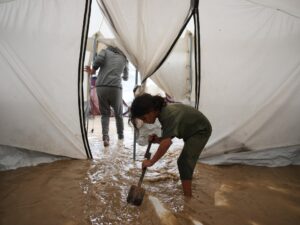Israel’s more than two-year genocidal war has forced nearly all of Gaza’s two million people from their homes to live in makeshift tents in displacement camps.
Added to their suffering is the prospect of harsh winter storms and flooding that might see even these temporary shelters, which are unable to withstand harsh conditions, disappear.
Recommended Stories
list of 3 itemsend of list
Gaza has already been subjected to worsening weather conditions.
“Over the past 24 hours, we’ve seen strong wind, heavy rainfall and plummeting temperatures here, turning many of the displacement areas here into pools of muddy water,” said Al Jazeera’s Hani Mahmoud, reporting from Gaza City.
“We have areas that have been completely submerged by water, areas that were flooded by the heavy rainfall that was mixed with sewage water as well, making it very dangerous for people here.”
These conditions have reduced whole families to scooping muddy water from their tents using only buckets and holding down their tents using other rudimentary tools such as rocks and blocks, in the hopes of protecting the few belongings they have left.
“All the tents are destroyed. Our tents are just made of fabric. Our children are drowning. There’s nothing for us to wear, no clothes to put on,” Assmaa Fayad, a displaced Palestinian, told Al Jazeera.
Thousands of tents damaged
The United Nations Refugee Agency (UNHCR) last week said the downpours have damaged at least 13,000 tents.
“Many of these displacement sites are pitched in open areas or the ruins of many of the destroyed buildings here [in Gaza],” said Al Jazeera’s Mahmoud.
The problem with these buildings is that “they’re cracked in the walls … in the ceilings”, which also makes the living conditions in these buildings difficult, said Mahmoud.
Under a United States-brokered ceasefire, which took effect on October 10, and which Israel has violated hundreds of times, aid deliveries were supposed to be significantly ramped up, with at least 600 trucks a day due to enter Gaza to fulfil the population’s needs.
However, Gaza’s Government Media Office has said only an average of 145 trucks have been entering Gaza since the ceasefire.
The UNHCR said in a post on social media that “thousands of internally displaced people in the Gaza Strip are struggling to find safe shelter in preparation for the coming cold weather”. “More shelter materials are still needed,” it added.
Aid organisations say that at least 300,000 mobile homes and tents are needed to house displaced people.
The UN agency for Palestinian refugees (UNRWA) has said that more than 79,000 displaced people are living in 85 UNRWA-run shelters in the Gaza Strip.
‘Siege policy’
The Palestinian Mujahideen Movement issued a statement, condemning the lack of supplies to help Palestinians as winter approaches.
“The suffering of our people in Gaza, especially the displaced, has worsened amid the cold and rainy weather. The flooding of the displaced persons’ tents is a direct result of the Zionist [Israeli] siege policy and the prevention of the entry of basic necessities, all while the world remains silent”.
The Palestinian Mujahideen Movement also called on the international community to “take immediate action and pressure the Zionist enemy to open the crossings and allow the entry of aid and essential supplies”.
Hamas spokesperson Hazem Qassem wrote a message on Telegram: “All the world’s efforts to alleviate the disaster have failed because of the Israeli siege.”
The sunny and dry weather conditions on Wednesday provide little relief, said Al Jazeera’s Mahmoud, as “a lot of people worry that by the evening, winds will pick up again”.
https://www.aljazeera.com/news/2025/11/26/powerful-storms-floods-bring-new-challenges-to-palestinians-in-gaza?traffic_source=rss



